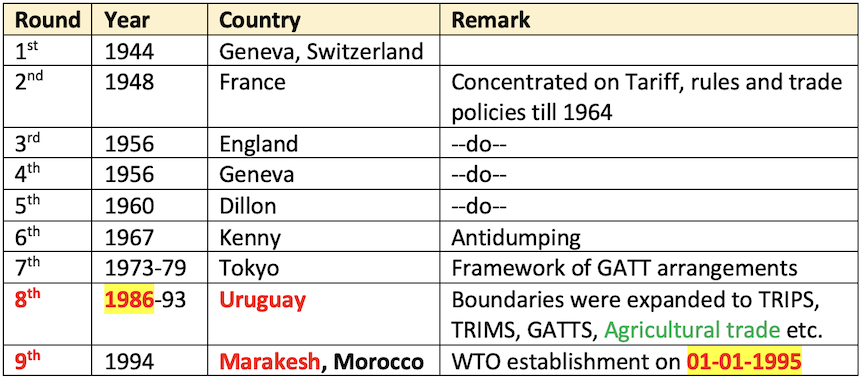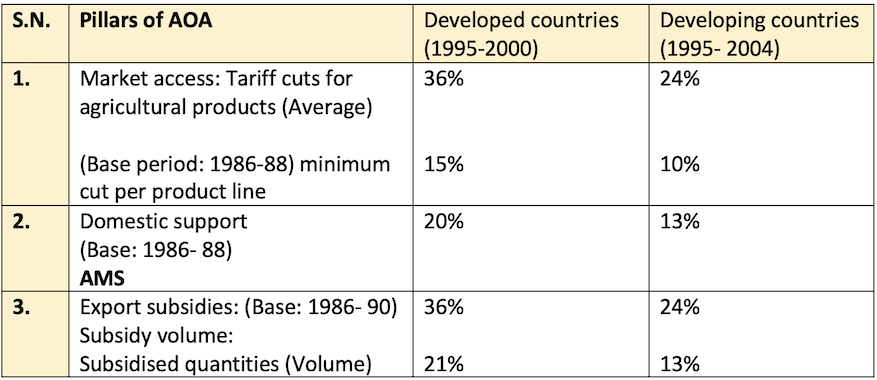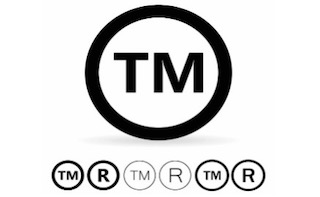🌍 WTO
Learn about World Trade Organisation
Genesis of GATT/ WTO
Brettonwood conferenceof 1944 recognized the need for an institution to oversee the liberalization of free trade.- For facilitating world trade, General Agreement on Tariffs and Trade (GATT) was established in
1947atGenevain Switzerland. - India was founder member of GATT.
- There have been several rounds of negotiations between 1947-94.
Main features of GATT (General Agreement on Tariffs & Trade)
- Reduction in agricultural tariffs by 30 % for all agricultural commodities from 1994.
- Agricultural input subsidies are reduced by 30 %, export subsidies by 36 % and value of subsidized exports by 21 %.
- Trade liberalisation policies would bring about 2-10 % rise for agricultural commodity prices in international markets resulting in a gain of $ 200 billion.
- As import tariffs are reduced, the domestic demand for imports increases putting pressure on trade balances. The developing countries have to resort to real exchange rate devaluation to increase their exports.
- GATT reforms are more beneficial to developed countries because of high prices for export goods such as capital goods, machinery etc.
- According to GATT, India can offer subsidy to increase its export competitiveness without altering policy related to PDS, food security etc.
- Under TRIPS, seeds and plant varieties must be protected either by patents or by an effective system of its own or a combination of both.
- All regulations, rules, restrictions (QRs), export duties, minimum export prices have to be removed to boost exports.
- TRIMS: No restrictions on quantum of foreign investment.

- Till 1964, negotiations were concentrated on tariff, rules, trade policies under GATT.
- In 1982, US suggested new items such as TRIPS, agriculture and service sectors for inclusion in the discussions. Several nations opposed the move initially. Ultimately everyone was forced to accept.
- 1989-94,
Dunkel draftwas discussed. Lot of opposition including India, but signed in 1994 atMarkeshin Morocco. - On the recommendation of Dunkel draft, WTO was established on
1st January, 1995with headquarters atGeneva. - At present there are
164 membercountries joined WTO as on 2021. - Afghanistan is the newest member, joining effective 2021
- Three divisions of WTO:
- Ministerial level conference: Meet once in two years to take principal policy decisions.
- General council: Consists of all members, handles day to day work of WTO.
- Bodies: (a) Dispute Settlement Body, (DSB) (b) Trade Policy Review Body (TPRB).
Main Functions of WTO
- In addition to goods, it covers trade in services, TRIPs and TRIMs.
- Dispute settlement system is faster and more automatic aims at solving trade problems.
- WTO has global states similar to IMF and World Bank.
Agreement on Agriculture (AoA)
- AoA was signed as part of the
Uruguay Round Agreementin April,1994. - It came into force with effect from
1st January, 1995. - AoA covers three broad areas of agriculture and trade policy, namely.
- Market Access
- Domestic Support
- Export subsidy
- Developed countries have to reduce their tariffs by an average of
36 %over a period of 6 years from 1995-2000, while developing countries to reduce by24 %in a span of 10 years from 1995 to 2004. Least developed countries are exempted. - India is under no obligation to reduce domestic support or subsidies currently extended to agriculture.
- No export subsidy has been extended in India.
Market Access, Domestic subsidy and Export subsidy commitments under AOA

Aggregate measure of support (AMS)
- Subsidies are considered to be market distortions and have a reduction commitment based on product specific and non-product specific calculations of AMS, based on levels of 1986-88 expressed as a percentage and the value of the production of the relevant agricultural product or entire agricultural production.
- There was no requirement in the agreement for reduction commitment if the AMS was 5% for developed countries and 10% for developing and least developed countries.
- In other cases member countries were required to reduce their total AMS by 20 % over 6 years by developed countries and 13.3 % over 10 years by developing countries.
- Exemption from AMS calculations were granted to green box and blue box subsidies.

Agreement on the Application of Sanitary and Phytosanitary Measure (SPS)
- SPS deals with standards for food safety and animal and plant health. WTO encourages member countries to use international standards or guidelines where they exist and names some examples are given below:
- Codex Alimentative commission is named for food safety which is an inter-governmental body of FAO & WHO.
- International office of Epizootics for animal health.
- FAO secretariat of the International plant protection convention for plant health.
- Higher standards are based on scientific justification, which is based on “risk assessment”.
Trade Related Intellectual Property Rights (TRIPs)
👉🏻 Different form of intellectual property rights (IPR) identified by TRIPs Agreement governed by WTO are
1. Patent
- A patent is an exclusive right granted to the inventor to use and market the invention for a limited period of time in consideration of the disclosure of the invention.
- The product must be (a) novel, (b) have industrial application and (c) must be useful for entitlement of a patent. Patents are given only for inventions. Inventions are solutions to specific problems in the field of technology. An invention may relate to a product or a process.
- Patent in India is granted under Patent Act, 1970 and is valid for 20 year.
2. Copy Rights
- Copy right law deals with the rights of intellectual creators.
- It is concerned with protecting creativity and ingenuity.
- It promotes and disseminates national cultural heritage.
- It is meant for original literary, dramatic, musical and artistic works, cinematographic films and software.
- Copy right is registered at Ministry of HRD which is valid for 60 years after author’s death.

3. Trade mark
- It is a sign that individualize the goods of a given enterprise and distinguishes them from the goods of its competitors. It is limited to word marks, abbreviations, names, figures and hologram.

4. Designs
- A design includes features of structure, configuration, pattern, ornament, or composition of lines and colors applied to an article in 2 or 3 dimensional form by any technical process.
- The process or product can be manual, civil, electrical, chemical and mechanical or combination of all.
5. Trade secret
- It is the agreement between the employer and employee to keep the research information secret or confidential. The employer can recover damages from the improper disclosure or use of his trade secret by the employee.
6. Geographical Indication
- Place names used to identify products such as “Champagne”, Roquefort cheese, Basmati rice etc.
- They provide legal means so that interested parties can stop the use of such geographical indications for products that do not originate from the used place name or do not have the usual characteristics associated with that place name.
Genesis of GATT/ WTO
Brettonwood conferenceof 1944 recognized the need for an institution to oversee the liberalization of free trade.- For facilitating world trade, General Agreement on Tariffs and Trade (GATT) was established in
1947atGenevain Switzerland. - India was founder member of GATT.
- There have been several rounds of negotiations between 1947-94.
Main features of GATT (General Agreement on Tariffs & Trade)
- Reduction in agricultural tariffs by 30 % for all agricultural commodities from 1994.
- Agricultural input subsidies are reduced by 30 %, export subsidies by 36 % and value of subsidized exports by 21 %.
- Trade liberalisation policies would bring about 2-10 % rise for agricultural commodity prices in international markets resulting in a gain of $ 200 billion.
- As import …
Become Successful With AgriDots
Learn the essential skills for getting a seat in the Exam with
🦄 You are a pro member!
Only use this page if purchasing a gift or enterprise account
Plan
Rs
- Unlimited access to PRO courses
- Quizzes with hand-picked meme prizes
- Invite to private Discord chat
- Free Sticker emailed
Lifetime
Rs
1,499
once
- All PRO-tier benefits
- Single payment, lifetime access
- 4,200 bonus xp points
- Next Level
T-shirt shipped worldwide

Yo! You just found a 20% discount using 👉 EASTEREGG

High-quality fitted cotton shirt produced by Next Level Apparel